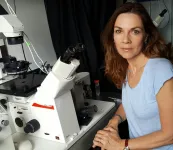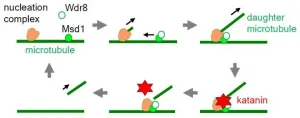Prototype may diagnose common pregnancy complications by monitoring placental oxygen
NIH researchers pursue innovative method for observing maternal and fetal health during pregnancy
2021-06-17
(Press-News.org) Researchers at the National Institutes of Health have developed a prototype device that could potentially diagnose pregnancy complications by monitoring the oxygen level of the placenta. The device sends near-infrared light through the pregnant person's abdomen to measure oxygen levels in the arterial and venous network in the placenta. The method was used to study anterior placenta, which is attached to the front wall of the uterus. The researchers described their results as promising but added that further study is needed before the device could be used routinely.
The small study was conducted by Amir Gandjbakhche, Ph.D., of the Section on Translational Biophotonics at NIH's Eunice Kennedy Shriver National Institute of Child Health and Human Development (NICHD), and colleagues. It appears in Biomedical Optics Express.
The researchers devised mathematical methods to study the passage of light through the skin, abdominal wall and uterine tissue to reach the placenta and calculate its oxygen levels. Currently, the device cannot monitor oxygen in women with a posterior placenta, which is attached to the back wall of the uterus, because the distance is too far for the light to travel. However, anterior placenta is associated with a higher rate of complications than posterior placenta, such as postpartum hemorrhage and an increased need for labor induction or cesarean delivery.
The researchers enrolled 12 pregnant women with an anterior placenta in the study. Of these, five had a pregnancy complication, including hypertension, a short cervix and polyhydramnios (excess amniotic fluid). On average, the women with complications had a placental oxygen level of 69.6%, a difference statistically significant from the 75.3% seen in the healthy pregnancies in the study. The authors see their results as a first step in continuously monitoring placental oxygen levels to assess maternal and fetal health.
INFORMATION:
[Attachments] See images for this press release:

ELSE PRESS RELEASES FROM THIS DATE:
2021-06-17
People--who get lost easily in the extraordinary darkness of a tropical forest--have much to learn from a bee that can find its way home in conditions 10 times dimmer than starlight. Researchers at the Smithsonian Tropical Research Institute's (STRI) research station on Barro Colorado Island in Panama and the University of Lund in Sweden reveal that sweat bees (Megalopta genalis), find their way home based on patterns in the canopy overhead using dorsal vision. This first report of dorsal navigation in a flying insect, published in Current Biology, may be of special interest to makers of drones and other night-flying vehicles.
"One of the pioneers of studies on homing behaviors in bees was Charles H. Turner, an African-American scientist from the University ...
2021-06-17
Bacteria do not sexually reproduce, but that does not stop them from exchanging genetic information as it evolves and adapts. During conjugal transfer, a bacterium can connect to another bacterium to pass along DNA and proteins. Escherichia coli bacteria, commonly called E. coli, can transfer at least one of these gene-containing plasmids to organisms across taxonomic kingdoms, including to fungi and protists. Now, researchers from Hiroshima University have a better understanding of this genetic hat trick, which has potential applications as a tool to promote desired characteristics or suppress harmful ones across genetic hosts.
They published their results on ...
2021-06-17
Young people with poor mental health took a turn for the better during the pandemic but those with good mental health saw a considerable decline, new research reveals.
The first nationally representative evidence regarding the diverse impact of the COVID-19 pandemic on adolescent mental health in the UK was led by researchers at Lancaster University working with the University of British Columbia in Canada.
Adolescents (aged 10 to 16) with better than average mental health before the pandemic experienced an increase in their emotional and conduct problems, hyperactivity, and problems interacting with their peers and friends, but a decrease in their prosocial ...
2021-06-17
Scientists have identified key molecular events in the developing human embryo between days 7 and 14 - one of the most mysterious, yet critical, stages of our development.
The second week of gestation represents a critical stage of embryo development, or embryogenesis. Failure of development during this time is one of the major causes of early pregnancy loss. Understanding more about it will help scientists to understand how it can go wrong, and take steps towards being able to fix problems.
The pre-implantation period, before the developing embryo implants into the mother's womb, has been studied extensively in human embryos ...
2021-06-17
Ikoma, Japan - The katana, a Japanese sword, may be thought of solely as a weapon used by the samurai. But researchers from Japan have discovered that not only do plants wield their own katanas within their cells, they recruit them to specific locations within those cells to do their work.
In a study published in Nature Communications, researchers from Nara Institute of Science and Technology have revealed that the enzyme katanin, which is named after the katana, is used by an anchoring complex to cut microtubules at specific locations of the framework within individual plant cells.
Katanin ...
2021-06-17
NEW YORK (June 17, 2021)--New York City neighborhoods that had higher levels of socioeconomic disadvantage experienced more COVID-19 infections and deaths, according to Mount Sinai scientists who created a neighborhood-level COVID-19 inequity index.
The index measured factors that fueled inequities in the residents' lives, such as employment and commuting patterns, population density of their neighborhood, food access, socioeconomic status, and access to health care. This allowed the scientists to compare between neighborhoods the contributions of these social factors in facilitating disease transmission during the first wave of the pandemic in a study published in Nature Communications in June.
"Much of the early rhetoric around COVID-19 ...
2021-06-17
As almost all our private information is digitalized, it is increasingly important that we find ways to protect our data and ourselves from being hacked.
Quantum Cryptography is the researchers' answer to this problem, and more specifically a certain kind of qubit - consisting of single photons: particles of light.
Single photons or qubits of light, as they are also called, are extremely difficult to hack.
However, in order for these qubits of light to be stable and work properly they need to be stored at temperatures close to absolute zero - that is minus ...
2021-06-17
AI is used in an array of extremely useful applications, such as predicting a machine's lifetime through its vibrations, monitoring the cardiac activity of patients and incorporating facial recognition capabilities into video surveillance systems. The downside is that AI-based technology generally requires a lot of power and, in most cases, must be permanently connected to the cloud, raising issues related to data protection, IT security and energy use.
CSEM engineers may have found a way to get around those issues, thanks to a new system-on-chip they have developed. It runs on a tiny ...
2021-06-17
Bottom Line: Genetic mutations indicative of DNA damage were associated with high red meat consumption and increased cancer-related mortality in patients with colorectal cancer.
Journal in Which the Study was Published: Cancer Discovery, a journal of the American Association for Cancer Research
Author: Marios Giannakis, MD, PhD, an assistant professor of medicine at Harvard Medical School and a physician at Dana-Farber Cancer Institute
Background: "We have known for some time that consumption of processed meat and red meat is a risk factor for colorectal cancer," ...
2021-06-17
The unique mechanical and optical properties found in the exoskeleton of a humble Asian beetle has the potential to offer a fascinating new insight into how to develop new, effective bio-inspired technologies.
Pioneering new research by a team of international scientists, including Professor Pete Vukusic from the University of Exeter, has revealed a distinctive, and previously unknown property within the carapace of the flower beetle - a member of the scarab beetle family.
The study showed that the beetle has small micropillars within the carapace - or the upper section of the exoskeleton - that give the insect both strength and flexibility to withstand damage very effectively.
Crucially, these micropillars are incorporated into highly regular layering in the exoskeleton ...
LAST 30 PRESS RELEASES:
[Press-News.org] Prototype may diagnose common pregnancy complications by monitoring placental oxygen
NIH researchers pursue innovative method for observing maternal and fetal health during pregnancy




